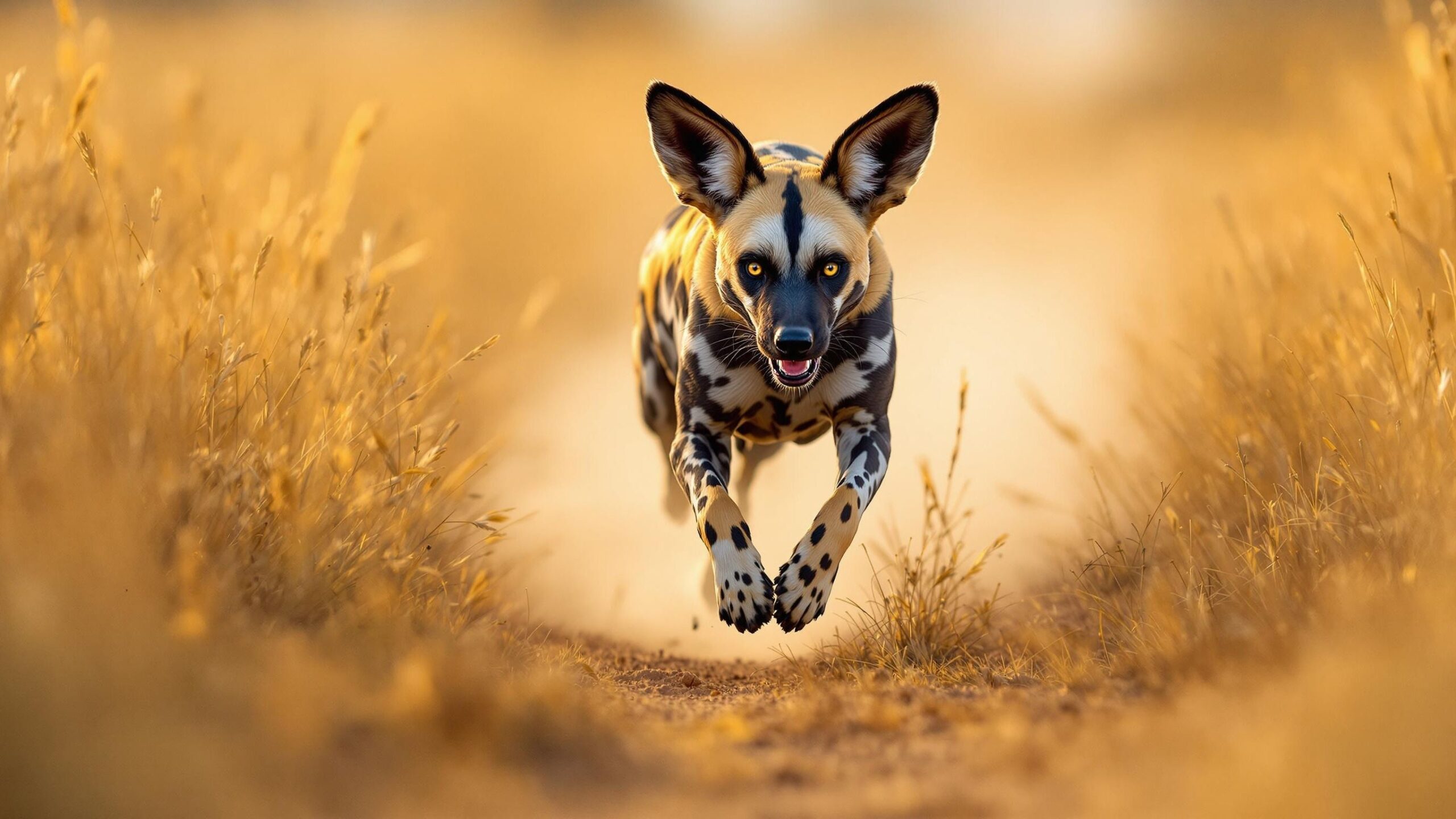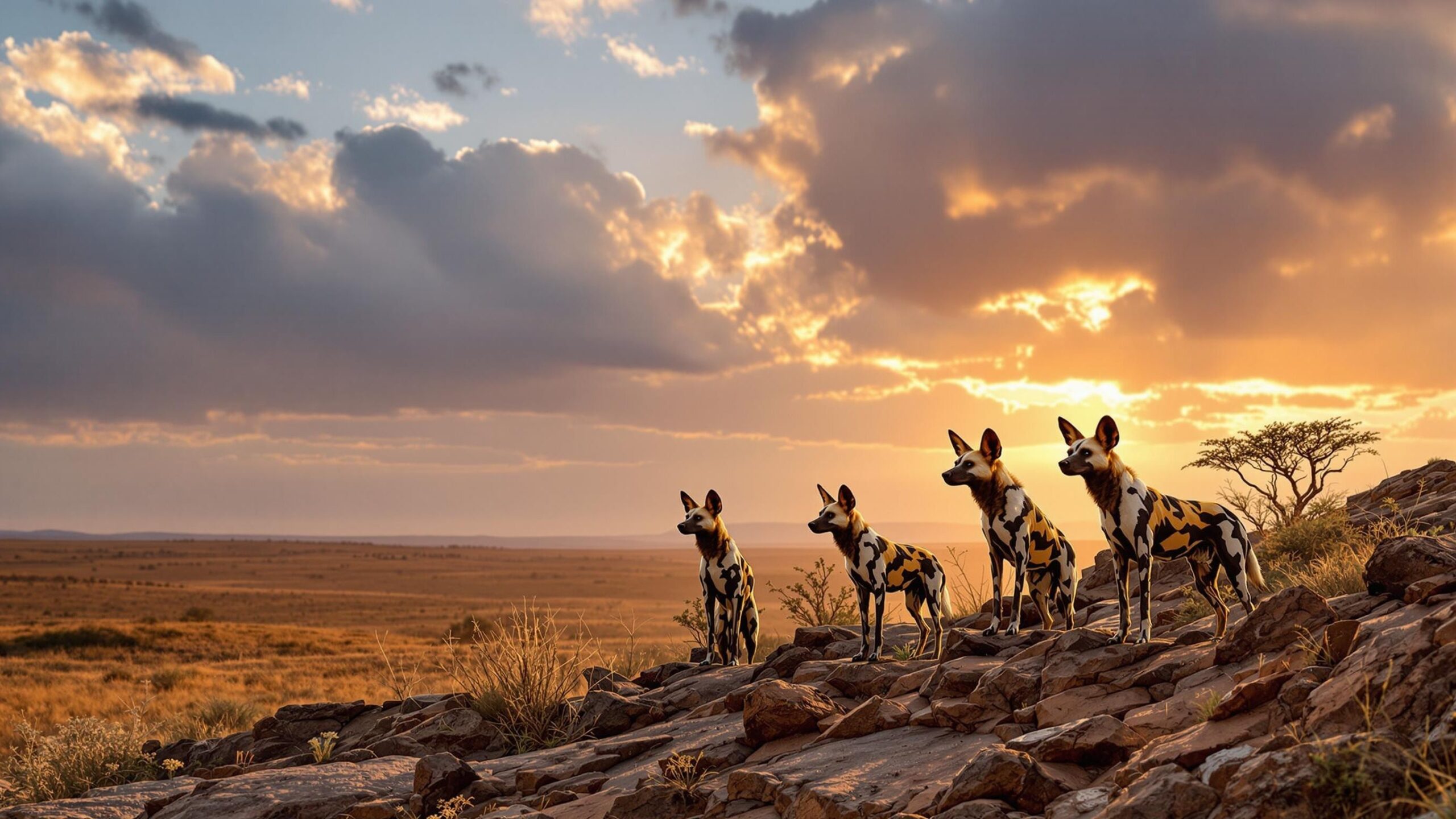East African Painted Dog: The Wild Spirit of the Savanna
Scientific Name: Lycaon pictus
In the heart of East Africa’s golden savannas and rugged woodlands roams one of the continent’s most charismatic and misunderstood predators—the East African Painted Dog (Lycaon pictus). Known for its striking coat, tireless endurance, and intricate pack dynamics, this animal is not only a symbol of wild Africa but also a vital thread in the fabric of its ecosystems. Sometimes called the African wild dog or simply painted wolf, this subspecies is a marvel of social cooperation, intelligence, and sheer beauty. Yet, despite its prowess and importance, it remains one of the most endangered carnivores in the world. Let’s journey into the vibrant, perilous world of the East African Painted Dog, uncovering its habits, habitat, biology, and the subtle yet pressing conservation story that surrounds it.
A Coat Like No Other: Appearance and Adaptations
The East African Painted Dog is a visual spectacle in motion. Unlike any other canine, its fur is a patchwork of black, white, yellow, and reddish-brown, arranged in patterns so unique that no two individuals are exactly alike—much like human fingerprints. These colors help break up their outline in the dappled light of their environment, acting as natural camouflage.
They are slender, long-legged hunters, weighing between 40 and 70 pounds, with males typically slightly heavier than females. Their large, rounded ears aren’t just endearing—they serve vital functions in thermoregulation and detecting distant sounds, enabling the dogs to stay in touch over long distances during their hunts or travels. The muzzle is dark and narrow, the limbs are built for speed and stamina, and the tail, often tipped in white, helps pack members keep visual contact during fast-paced chases. What’s missing, notably, is a dewclaw—a feature present in most dogs. Evolution, it seems, trimmed away anything that would slow them down. The East African Painted Dog is leaner, lighter, and built purely for efficiency.
The Territory of the Painted Dog: Where They Live
The East African Painted Dog is primarily found in countries like Tanzania and Kenya, with smaller, fragmented populations in southern Ethiopia and parts of Uganda. Its habitat includes a mix of open plains, wooded savannas, and dry forests. These regions offer a rich tapestry of prey animals and enough cover for denning and raising pups.
Historically, painted dogs roamed much wider across the continent, from deserts to mountains. Today, human expansion and habitat fragmentation have pushed their range into isolated pockets, making it harder for separate packs to interbreed or migrate. Still, in protected areas like Serengeti National Park, Selous Game Reserve, and Laikipia Plateau, some of the healthiest populations continue to thrive—albeit under the watchful eye of researchers and conservationists. The painted dog’s lifestyle depends heavily on vast, unbroken tracts of land. Their need to travel great distances during a hunt—sometimes covering over 12 miles in a day—means small reserves or fenced landscapes are often insufficient for sustaining viable populations.
Pack Life: The Social Fabric of Painted Dogs
Perhaps the most fascinating trait of the East African Painted Dog is its extraordinary social structure. Packs usually consist of 6 to 20 individuals, though some groups swell to 30 or more in optimal conditions. These packs operate with stunning coordination, relying on strong social bonds and cooperative behaviors. A dominant alpha pair leads the pack, but unlike in many mammalian societies, leadership here doesn’t rely on brute strength. Painted dogs display a rare sense of unity and mutual care. For instance, when one member is injured or sick, others will feed and protect it. All members participate in raising the pups—feeding them, guarding them, and teaching them essential survival skills. Communication is key in such an interconnected society. The dogs use a range of vocalizations including chirps, squeaks, and a unique twittering sound to stay in touch. When hunting or regrouping, they often perform elaborate greeting rituals, wagging tails and licking one another’s faces in displays of affection and affirmation.
This deep-rooted cooperation gives the East African Painted Dog a distinct edge in survival, particularly in the wild where unity often determines the difference between life and death.
Masters of the Chase: Hunting and Diet

There are few predators as effective as the painted dog when it comes to the hunt. Unlike ambush predators such as leopards or solitary hunters like cheetahs, painted dogs rely on endurance, coordination, and speed. Their hunting success rate hovers around an impressive 70 to 80 percent—far higher than lions or hyenas. Their strategy? Packwork. Once prey is spotted—usually medium-sized ungulates like impalas, gazelles, or even young wildebeest—the dogs set off in a strategic pursuit. Some individuals chase and drive the prey, while others flank or intercept. Communication continues throughout, with dogs adjusting direction based on real-time vocal cues.
When the prey is downed, the feeding process is swift. Everyone eats, starting with the young and injured. The pack’s selfless approach contrasts with the often competitive and hierarchical feeding seen in other carnivores. Despite their skills, painted dogs face stiff competition. Lions and hyenas will steal their kills when possible, and the dogs, being smaller and outnumbered, usually don’t put up a fight. Avoidance, rather than confrontation, is their preferred tactic.
A Life on the Move: Breeding and Pups
Breeding typically occurs once a year, with the alpha female giving birth to a litter of 6 to 12 pups in a carefully chosen den—usually an abandoned aardvark or warthog burrow. These dens provide shelter from predators and harsh weather during the pups’ most vulnerable early weeks.
After about 10 weeks, the pups emerge from the den and begin interacting more with the rest of the pack. At this stage, the adults prioritize the needs of the young. Regurgitated food is brought back after hunts specifically for the pups, and the pack reduces its mobility to allow the youngsters time to grow and learn.
By six months, the pups start joining the adults on hunting trips, watching and mimicking behaviors. They are not just tagging along; this is active education in the wild. The pack’s investment in its young is one of the reasons for their high survival rate—another example of how cooperation is the linchpin of their success.
Facing the Edge: Threats and Challenges
While the East African Painted Dog is a formidable survivor, its future remains perilously uncertain. Across Africa, fewer than 6,000 individuals remain in the wild, and within the East African region, their numbers are thought to be in the low hundreds.
Habitat fragmentation is the primary threat. As human development, agriculture, and roads carve up the landscape, the painted dogs lose the room they need to roam, hunt, and connect with other populations. Isolation reduces genetic diversity and increases the likelihood of inbreeding. Road kills are an increasingly frequent cause of mortality, especially near national parks where painted dogs may cross highways or unpaved roads. Disease also takes a heavy toll. Rabies and canine distemper, often spread by domestic dogs, can wipe out entire packs in a matter of weeks.
Human-wildlife conflict remains a constant tension. Despite their rarity, painted dogs are sometimes targeted by farmers who fear for their livestock, even though incidents of actual predation on domesticated animals are comparatively low. Efforts to trap or poison other carnivores can also inadvertently harm painted dogs. Once viewed by settlers as vermin, these dogs are still trying to outrun the shadow of old reputations.
Glimmers of Hope: Conservation Efforts
Though the challenges are many, there is hope on the horizon. Numerous conservation organizations and wildlife authorities are working to protect East African Painted Dogs through a combination of science, community outreach, and habitat preservation. Programs aimed at disease vaccination, particularly in domestic dog populations near parks, have shown promise in preventing devastating outbreaks among painted dog packs. Conservationists are also working to establish wildlife corridors that allow animals to move safely between protected areas, helping to maintain genetic flow and ecological resilience.
In Kenya and Tanzania, tracking and collaring programs help researchers better understand movement patterns and behavior. This data can guide policy and inform infrastructure planning, such as road construction, to mitigate threats. Perhaps most importantly, local education initiatives are reshaping the way communities perceive painted dogs. By promoting coexistence and illustrating the dogs’ ecological value, attitudes are beginning to shift from hostility to stewardship.
The Cultural Legacy of the Painted Dog
While much of the public attention has gone to lions, elephants, and rhinos, the painted dog holds its own place in African cultural heritage. In some East African traditions, the animal is seen as a symbol of unity, strategy, and kinship—traits that resonate deeply with the social structure of human communities. In modern times, painted dogs have inspired documentaries, art, and photography projects. Their expressive eyes and colorful coats make them a favorite among wildlife enthusiasts and conservation storytellers. Their story is not only about survival in the wild but also about the possibility of harmony between people and nature.

The Painted Dog’s Place in the Ecosystem
Beyond their aesthetic and cultural value, East African Painted Dogs play a vital ecological role. As apex predators, they help maintain the balance of herbivore populations. Their hunts often target the weak, sick, or old, keeping prey species healthy and preventing overgrazing of the landscape. Their presence indicates the health of their habitat. In regions where painted dogs thrive, it’s often a sign that the broader ecosystem—prey base, vegetation, predator balance—is in good shape. Their decline, therefore, is not just a tragedy for their species, but a warning about the wider fragility of the wild places they inhabit.
Running with the Pack
The East African Painted Dog, with its kaleidoscope of colors, unbreakable social ties, and relentless energy, embodies the soul of the African wilderness. It’s a creature that defies expectations—fierce yet caring, elusive yet deeply communal, a hunter that shares and a leader that nurtures. Though their numbers are small, their story is mighty. In their struggle for survival lies a powerful message about what it means to live together, to support one another, and to protect the world we share. By preserving this singular predator, we do more than protect a species—we safeguard a living symbol of nature’s resilience, complexity, and grace.

